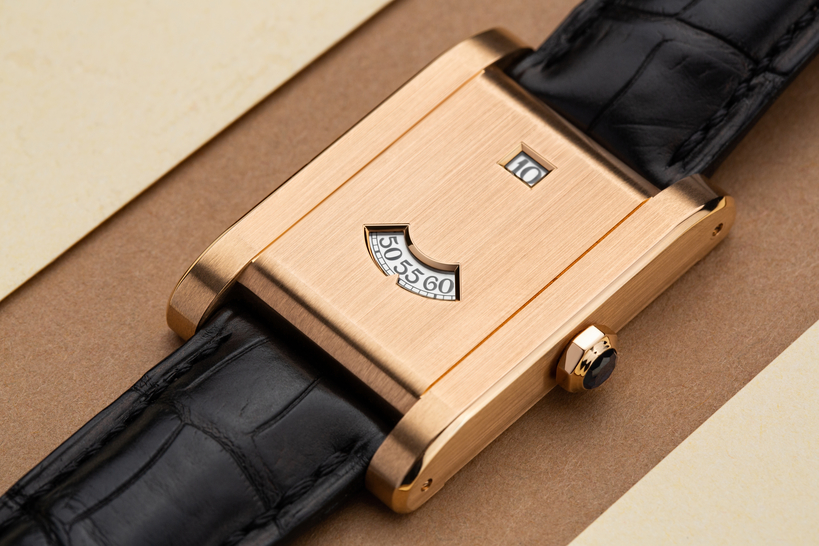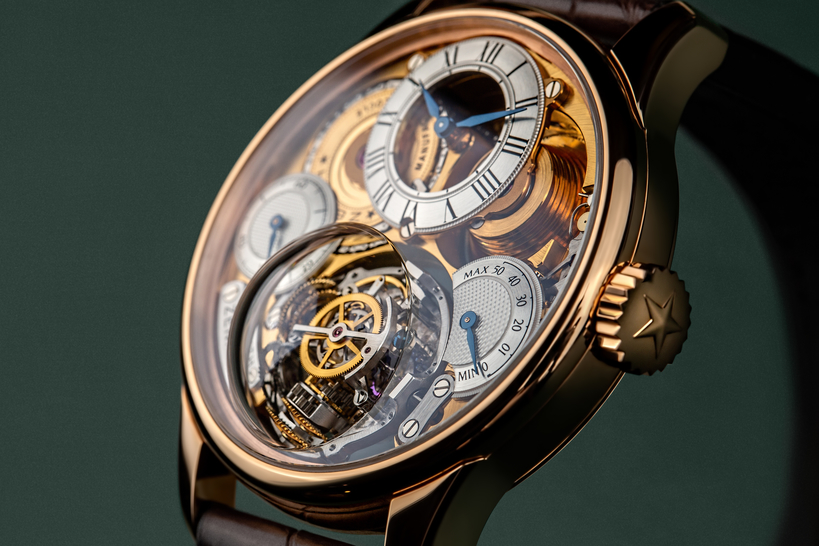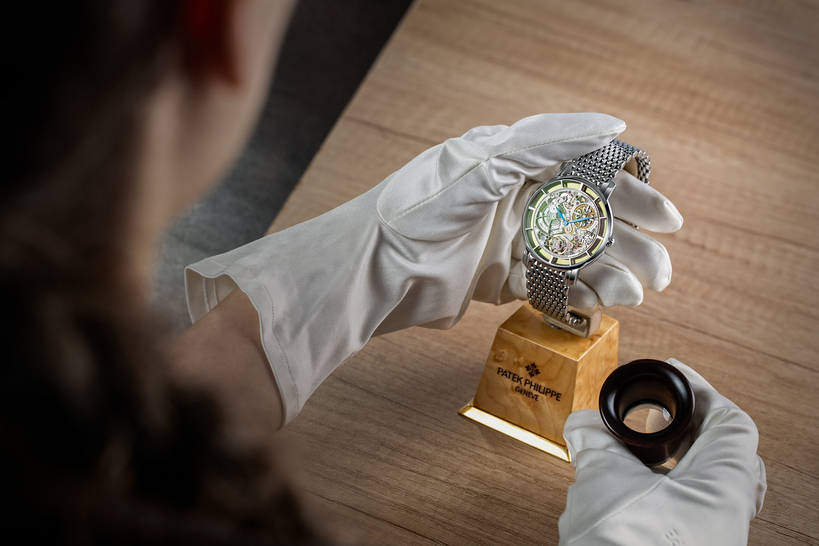The 53 unique watches will be sent on a tour from the end of September before being sold at the Only Watch auction in Geneva on November 6.
Beginning in Europe, the watches will travel on a route through the Middle East, the Far East, and then back to Europe. This will only be the ninth time Only Watch has been held, but the auction has already built up quite an impressive reputation.
This was the auction where the world record for the most expensive watch was set two years ago, when a minute repeater wristwatch called the Patek Philippe Grandmaster Chime ref. 6300A in stainless steel was sold for CHF 31 million.
There's a simple and very appealing concept behind the auction for collectors and fans of haute horlogerie: watch brands auction off special models which are either one-of-a-kind pieces or the first piece in a series. The funds raised at auction go towards a charity for research to help children with Duchenne muscular dystrophy.
How did this charity event become such a big deal? Only Watch started out as an auction which was timed to coincide with the Monaco Yacht Show, where the world's richest go to size up each other’s luxury yachts.
Watch manufacturers were attracted by the prospect of even indirectly participating in this event. The auction's results may have been fairly modest at the beginning, but its organizers have managed to raise the bar dramatically over the years. This has also worked in favor of major watch brands.
The great Patek Philippe blazed the trail by turning to steel, a material no one had paid much attention to before then. More importantly, the past eight auctions have raised over EUR 70 million, which has gone towards research to help sick children.
Two years ago in OW-2019 the Patek Philippe Grandmaster Chime ref. 6300A in stainless steel was sold for CHF 31 million
The favorites from the upcoming auction are all by the same sought-after brands whose watches are sold at other large and smaller-scale auctions. The following is our pick of models which deserve special attention.
Manual Time
The name of the model by F. P. Journe is FFC Blue, which can be decoded as follows: "FFC" stands for "Francis Ford Coppola" and "Blue" is a reference to the fact that this unique watch has been created based on the simplest yet most popular Chronomètre Bleu models.
The story of how this model was created is an interesting one. François-Paul Journe visited the great film director in 2012, who expressed the opinion that watches have been telling the time with hands in the same way since time immemorial, and that it's boring.
If only they could tell the time like people do using their fingers — now that would be cool. Journe took Coppola's joke seriously, challenge accepted! He brought the crazy idea to life nine years later by creating an automaton in the shape of a human hand, made in blued steel and placed in the center of the dial.
An arrow also made of blued steel points the minutes by crawling clockwise along the minute scale. The hand changes the position of its fingers once every hour according to a system similar to a referee's hand signals in basketball games.
On the watch, numbers one to four are counted on the fingers as usual, and five is shown with an open hand including the thumb. But they needed to come up with a unique system to tell the time for the rest of the hours. Six to nine are shown by beginning counting with the thumb for six, then adding the first three fingers to count to nine.
Ten is represented by a closed fist, eleven is a closed fist with the pinky finger sticking out, and twelve is a fist with the pinky and thumb sticking out. As a matter of fact, Journe asked Francis Ford Coppola to come up with this system himself.
The system he invented is an unusual one, but it's safe to say that it doesn't take long to get used to it. In terms of Journe's contribution, the brilliant watchmaker has set the automaton in motion using the automatic caliber 1300 as its base movement, which was initially only intended to move hour and minute hands.
The hand changes the position of its fingers once every hour according to a system similar to a referee's hand signals in basketball games.
The movement has been fit into a 42 mm tantalum case measuring just 10.7 in height. Tantalum is a material Journe has been focusing on this year. The lot is expected to be priced at CHF 300,000 – 400,000.
Farewell to Jumbo
At first glance, the next object watch collectors will be fighting over is probably a fairly conventional model by Audemars Piguet, the Royal Oak Jumbo (Ref. 15202XT). So what makes it so special?
First of all, it has a 39 mm sandblasted titanium case with polished chamfers. Secondly, its titanium bracelet, with its studs and folding clasp made of the brand's patented Bulk Metallic Glass (BMG) alloy.
This palladium-based alloy has an amorphous atomic structure which gives surface a glassy appearance and a glaringly alluring sheen. But the most important thing isn't a specification.
It's the fact that it looks like this will be the last of the Jumbos. Seriously, the famous independent manufacture is intent on sending the iconic model off for a well-earned rest.
Of course, there's an army of Royal Oak fans who don't want to believe this is happening, who are currently engaged in heated debates over whether the Jumbo will be suspended or discontinued forever.
But if the reasonable and clever auction policy Audemars Piguet adheres to is anything to go by, this really is the last Ref. 15202 Jumbo the watchmaker will ever make with the ultra-thin caliber AP2121 created fifty years ago based on the Jaeger-LeCoultre JLC920.
The public still have their doubts. How else can you explain the estimate for this lot, fluctuating within a range from CHF 160,000 to 320,000?
Patek & Kids
The majority of experts also expect there'll be intense bidding over a range of creations by the small independent brands gaining more and more weight at the auctions.
To be more specific, the candidates expected to do well at the upcoming auction are the likes of Andersen Genève's Quotidiana model with Edward Sexton, Urwerk's UR-102 Gaia, Konstantin Chaykin's impressive Martian Tourbillon.
And a piece with two faces jointly created by De Bethune and Kari Voutilainen called Kind of Magic, which houses the new OW21 movement with dual front and back display of hours and minute along with a deadbeat seconds complication. Its creators unfortunately insist photos of the watch should not be posted before the auction.
The candidates expected to do well at the upcoming auction are the Svend Andersen's Quotidiana, Urwerk's UR-102 Gaia, Konstantin Chaykin's Martian Tourbillon.
However, everyone knows that Patek Philippe will make the event as always. This time round, the great watchmaker has surprised us with a timepiece specially created for Only Watch which isn't even a wristwatch.
The Patek Philippe Ref. 27001M-001 is a desk clock, inspired by the timekeeper delivered to the famous automobile manufacturer James Ward Packard in 1923. The model's full name is the Patek Philippe Complicated Desk Clock Ref. 27001M-001.
According to Patek Philippe's own statement, it's the most unique watch made in the manufacturer's modern history, if only for the fact that two versions of the original desk clock from the 1920s were made.
The second belonged to the banker Henry Graves, a legendary collector of Patek Philippe timepieces. But the new clock is a real pièce unique. The Art Deco case is made of sterling silver with American walnut inlays (the original had a silver and gold case).
It measures 164.6 mm x 125 mm x 76.3 mm and houses the manual-winding 86-135 PEND IRM Q SE movement with a perpetual calendar, moon-phase display, week number and power reserve indicator (the clock can keep running on its own for 31 days).
The clock has a rose-gilt opaline dial like the golden opaline dial on the record-breaking Patek Philippe Grandmaster Chime ref. 6300A, presumably a subtle hint that the new model has a similarly outstanding and unforgettable fate in store.
Most would indeed argue that the estimate set at CHF 400,000 – 500,000 is clearly an underestimate. All of Patek Philippe's contemporary interior clocks tend to be the ones to watch. The watchmaker prefers not to disclose anything about them whatsoever. There's no mention of them in any of the press releases.
They go straight to the Patek Philippe stand, displayed in modest little glass cases, the kind which are "for members only". And practically every one them is a pièce unique, decorated using the finest of rare, complicated and unique techniques to create a timepiece which couldn't be anything less than the crème de la crème.
Schedule for promotional world tour of watches created for the Only Watch auction:
Monaco – September 22-25, Monaco Yacht Show
Dubai – September 30-October 3, Christie’s
Tokyo – October 8-10, Christie’s
Singapore – October 15-20, Malmaison by The Hour Glass
Hong Kong – October 25-28, Christie’s
Geneva – November 4-6, Four Seasons Hôtel des Bergues











